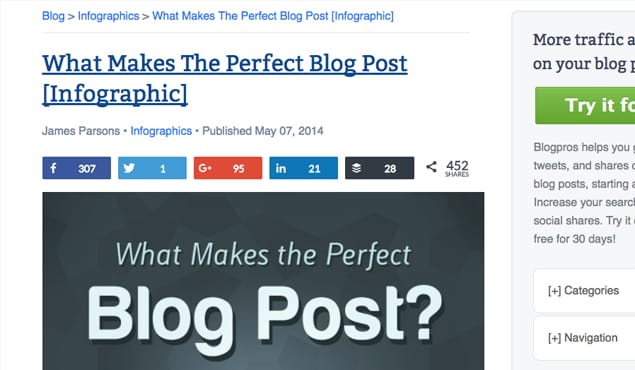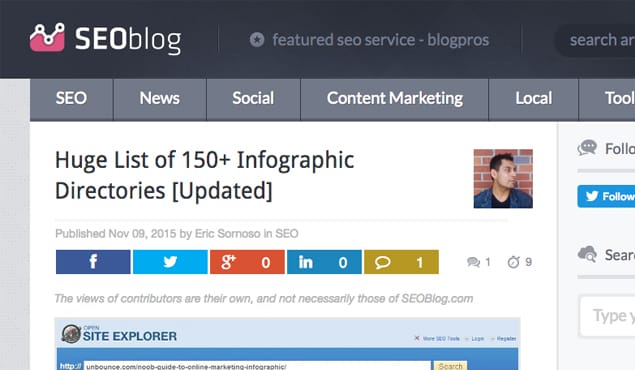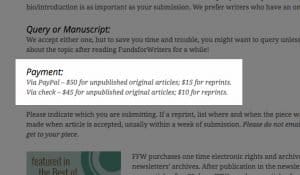Infographics are a pretty great way to gain exposure, get your brand name out there and recognized, and showcase how good you are at both design and at the critical thinking necessary to produce something thought provoking with solid data to back it up. However, an infographic only goes as far as you’re able to promote it. You can’t simply create them and let them languish, you need to get them out in the world, like wayward children, bringing honor to their clan.
There are many ways to promote an infographic, but today I’m specifically talking about using guest posting to do it. Guest posting is an art form, but what’s particularly tricky about it with infographics is the duplicate topic factor. Once your graphic has been out for a while, people start growing hesitant to dedicate their guest blog slots to something so covered. You need to go about guest posting the right way to find great success with infographics.
1. Create An Excellent Graphic
The first step to any good infographic marketing is to make a great graphic. There’s a lot that goes into it, of course. Above all else, though, you need a good sense of narrative. You can’t just present some data, otherwise you’re just making a glorified bar graph or pie chart. Make it attractive; hire a designer, create some illustrations, and make something actually worth sharing.
Conversely, you can’t go too deep, otherwise people will lose track of the flow of information as you cover too many points in too little detail. There’s an art to finding the right balance of data to conclusion, and I recommend studying successful infographics to get an idea of how they work. You can also read up on design tips from the pros, of course.
2. Build a List of Potential Post Publishers
Next up, you need to build a list of potential publishers for your infographic and guest post combination. Let’s say for the sake of this article that you’re making an infographic about teaching on a national scale. You’re discussing teacher to student ratios, budgets per student, and other metrics with some fancy graphics. You want to build a list of education, teaching, and education budgeting blogs to post on. You don’t want to post on any old site you find, though, because many of them don’t cover the right topic. I wouldn’t send such a graphic to Business Insider, but Forbes might do, and something like Teach100 or Principals Page would be fine.
3. Prune List for Best Tier Options First
For one of the later steps, you’re going to be writing unique articles for each of the blogs you’re posting on. This is to help those blogs with duplicate content issues and to help prevent yourself from running into syndication problems. In order to minimize the amount of work you’re doing, you want to prune your list of possible blogs down to, I would say, no more than five. You can really do as many as you want, of course. You just have to be able to make a unique article for each one, and the more you do, the more expensive, time consuming, and difficult this becomes. Keep your list sorted and in mind, though.
4. Identify Specific Contacts Within the Publishers
Before you send out your first pitch, you need to harvest contact information for submissions for each of the blogs you want to contact.
Your goal is to have all of your posts published pretty close to one another, so you want to start your outreach around the same time. See if you can get a direct connection to the managing editor of each blog in question, so you have someone you can contact on a more direct and reliable basis than using some website submission form. If you can’t get ahold of the information or a connection, pass on that site and find the next blog on your list.
5. Pitch Your Article Well Before Publication
The reason you want to aim for publication around the same time is to maximize the traffic surge. The more people who see your post, the better, but if they all see it at once it has a higher chance of trending on social media and going viral. In order to do this, you want to tell the people you’re pitching that you have some specific requests. Let them know that you’re producing an infographic about X topic and that you’d like to guest post about it on their site. Tell them you’d like it to be published around the time it is finished, but say that you don’t necessarily know when that will be. Try to manipulate them into accepting publication right around your goal date. Plus or minus a few days is fine, you just don’t want it spread out across weeks.
6. Aim for a Reasonable Number of Guest Posts
As I mentioned, you want a reasonable number of posts, primarily from a labor and/or expense standpoint. The more posts you try to do, and the less time you give yourself to do them, the harder it is to come up with unique and valuable content. You can outsource them, but then you run the risk of your writer creating too many similar posts, or multiple writers creating more or less the same post. However, you also don’t want to flood the world with your guest posts, because it makes the people who accept them feel less exclusive or special. It makes some of them less likely to accept more from you in the future.
7. Request Specific Publication Dates
Your ideal content distribution will be posting a post on your own blog with your infographic on one day, and then getting the guest posts published throughout the next two days.
This is the most organic and most valuable look. People assume those blogs found your content or gave you an opportunity because of it. If they publish first, you lose the initial source value on your blog. If you publish first but too early, the initial surge will have died down and you lose that boost to viral potential. In essence, it becomes old news.
8. Create Unique Articles for Each Site
I can’t stress this enough; every article you create for a guest post needs to be unique. They will all center around your infographic, of course, but they can’t just be rundowns of the content. They need to have value beyond just the graphic, and we’re talking 2,000-3,000 words of content here. These are beefy, valuable posts. They’re valuable even if the graphic is taken away. The graphic is just some additional meat on the rib, and it’s the center of the link back to your site.
Unique content is important for getting value from customized angles, maximizing the traffic from each individual site. Maybe one of those teaching blogs really takes teacher-student ratios as their core issue. Maybe another is all about budgets and unions. It’s important to tailor.
9. Create a Generic Press Release for Excess Sites
Once you have your core pitches and content accepted, it’s time to visit more of your list. The top 20-50 sites, depending on how broad you want to go, should have a press release made up for them. This press release can be generic, telling them about your content and why you think it fits with their blog. You don’t need to go into great detail, but neither are you intending for this press release to be published itself. Send it to the blogs who will write their own coverage of your infographic, with a “to be released” date of the day after you intend to get your guest posts published. You don’t want to undercut your top-tier blogs with mass publication elsewhere, but neither do you want to wait too long.
10. Publish Your Home Version A Day Before
The first and most important instance of your infographic should be published on your blog, with a great blog post surrounding it, full of excellent value.
Cite all of your sources, create a widget with embed code so anyone coming by can embed the post in their own site, and layer the thing up with customized tweets, calls to action, share buttons, and everything else. This is your hub of traffic, and you need to make sure all of your guest posts link to this specific post.
11. Follow Up With Promotion of the Guest Posts
Once the guest posts are published, you need to do your part for promotion. Share them in links throughout the next week or so of your blog posts, generally with a “thanks to X blog for sharing my graphic!” Share them on social media, on your feeds. Like and comment to them on their own social media posts, retweet them on Twitter, and do anything you can. Share them with exclusive groups and communities you’re a member of. Generally do your part to get as much traffic to those top-tier guest posts as possible. The better they perform, the more likely that site is to ask you back for another guest post in the future.
12. Submit Your Graphic to Graphic Directories Later
The general flow of publication starts with your post, then goes to your top tier unique guest posts, then goes to your press releases. After that, you want to submit the infographic itself to the various infographic directories out there.
Directories don’t tend to publish content beyond the graphic itself, nor do they tend to be great for either traffic or conversions. However, they do get a little extra boost, and all of the additional links and mentions give you more brand awareness and a minor SEO boost as well.
13. Maintain Your Editorial Relationships
Once the posts have been published and the traffic dies down, keep an eye on the places that published it. These sites are valuable to you, and you have started to form a relationship with the editors there. Make sure to maintain that relationship, both through casual communications and through passive value. Link to the sites in other unrelated blog posts, share their content on social media, and generally be a low-key benefit to their site. As you do this, you end up becoming a recognized name, and those sites are more likely to link to you, share your content, and accept future guest posts.
14. Monitor Performance and Identify the Best Publishers
All the while, you should be monitoring your traffic from the various referral sources embedded in each of these guest posts. You don’t necessarily need to go all the way to making UTM parameters for each unique post, but you can certainly monitor referral data in Google Analytics. As you monitor, correlate the size of the site with the amount of traffic it brings you. Identify which blogs perform better than expected and which are worse. Then analyze why. Was your content just not on focus for their blog? Did they not promote it as much? Did their readers take issue with something you said? Find the ones you worked best with and put them on the short list for future posts.
15. Wait a While Before Repeating
You don’t want to abuse or drain your resources by asking for “favors” too often. If you want to produce more infographics, you should aim for varied subjects so that you can find other blogs you can ask for guest posts. There are two reasons for this. The first is that they’re a little less likely to accept a second infographic post in a short amount of time. The second is because you want to have a diverse link profile on your site. Too many links from too few sources is one of the flags that Google uses to look for unnatural link building. They can and will penalize you for it, though generally that penalty will take the form of making most of the links less valuable. When you get your links from a wider variety of sources, you protect yourself from this problem.
 ContentPowered.com
ContentPowered.com









